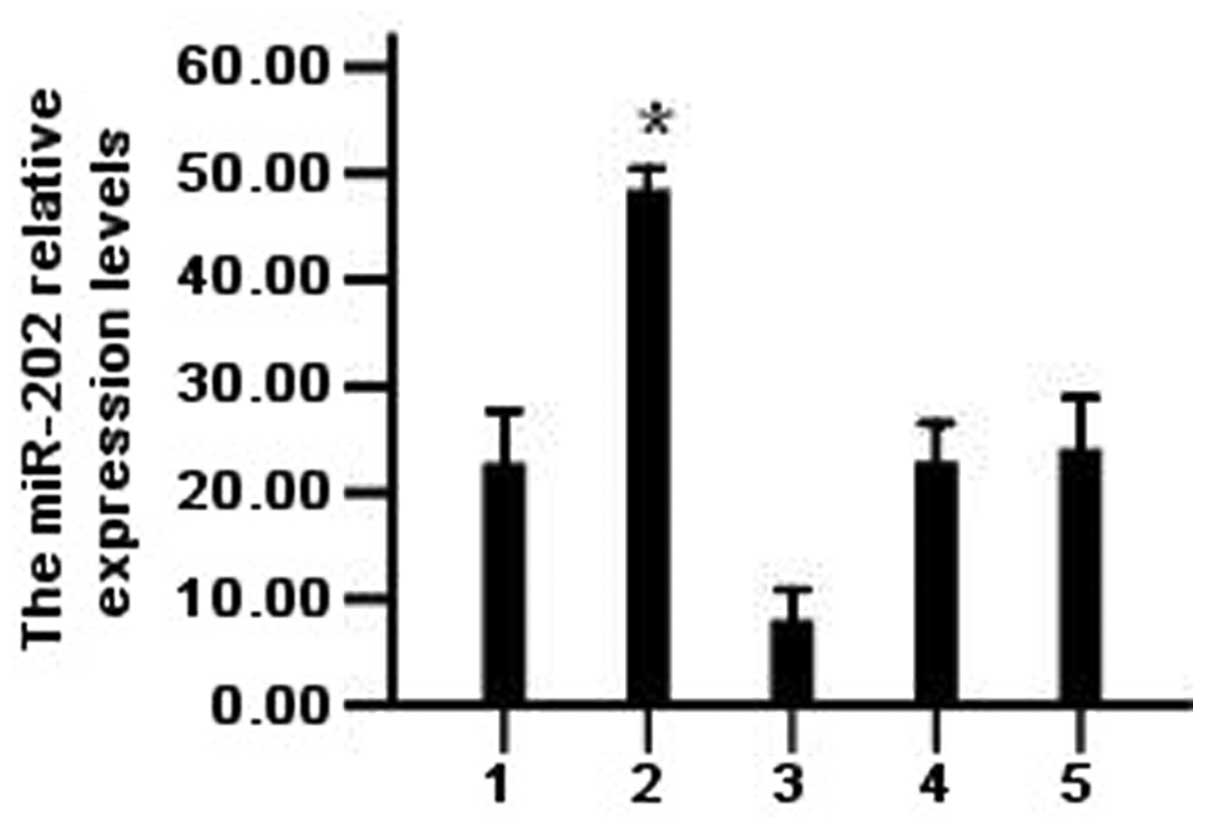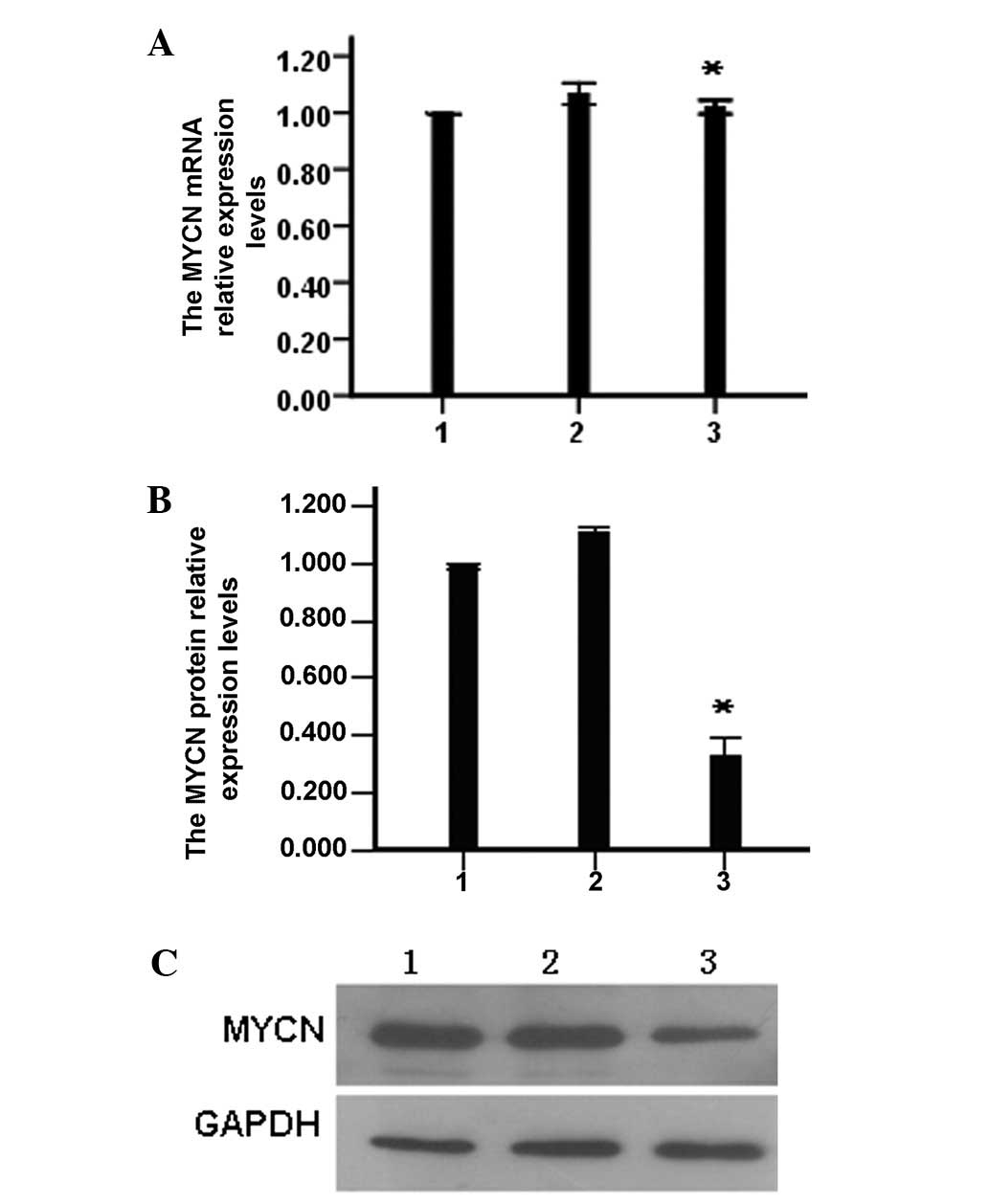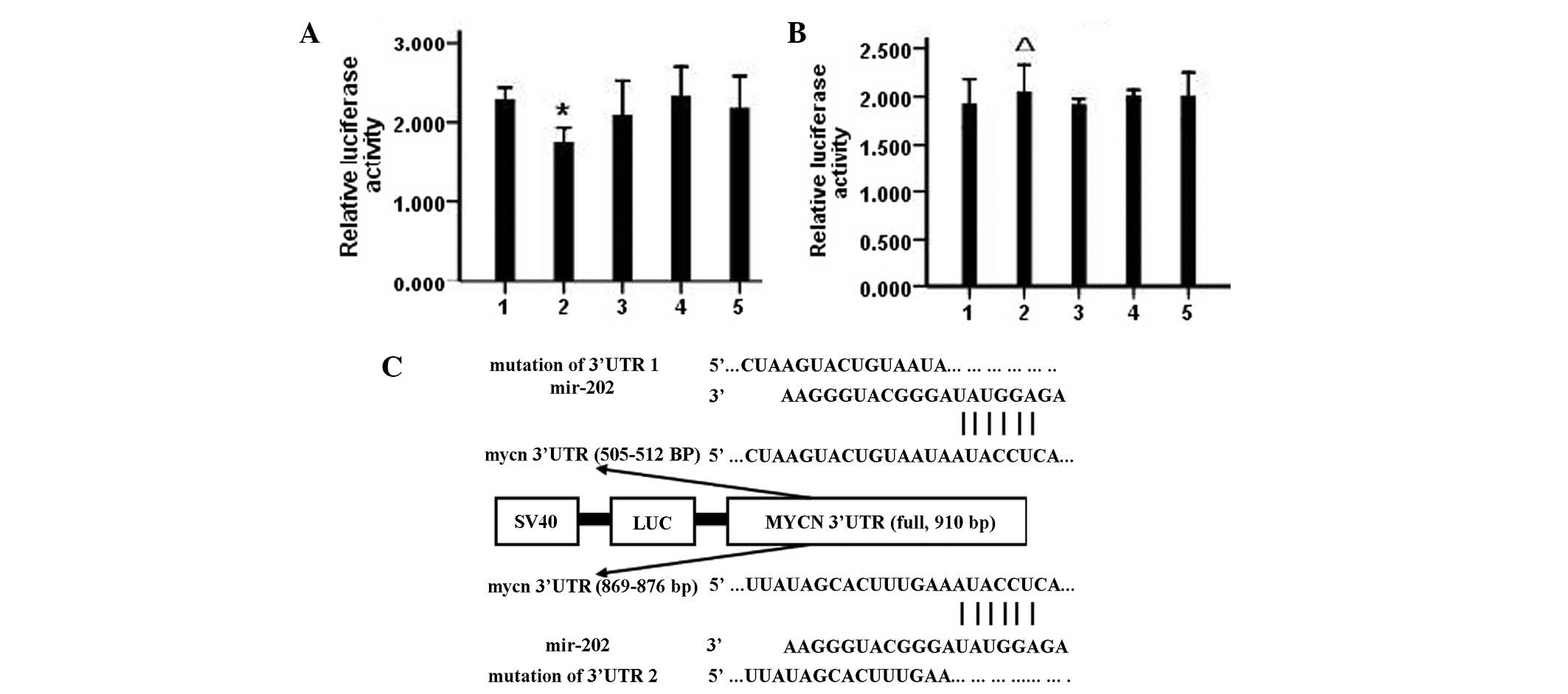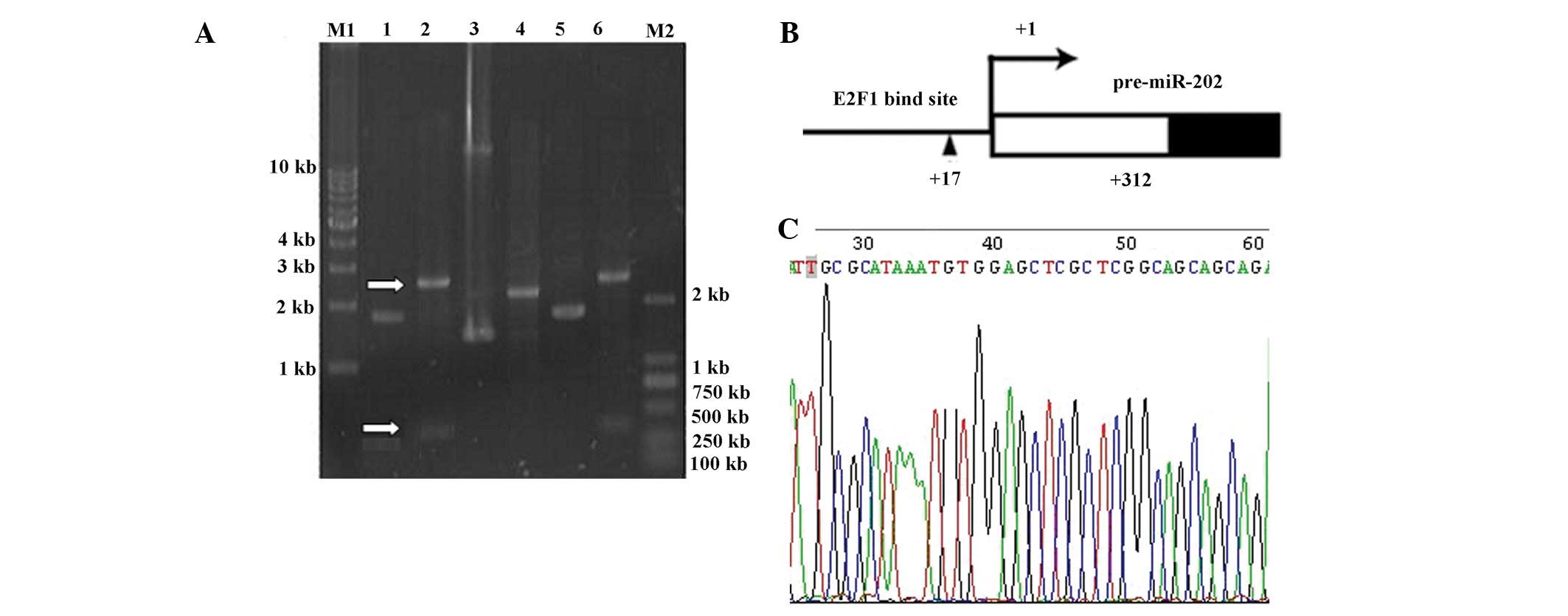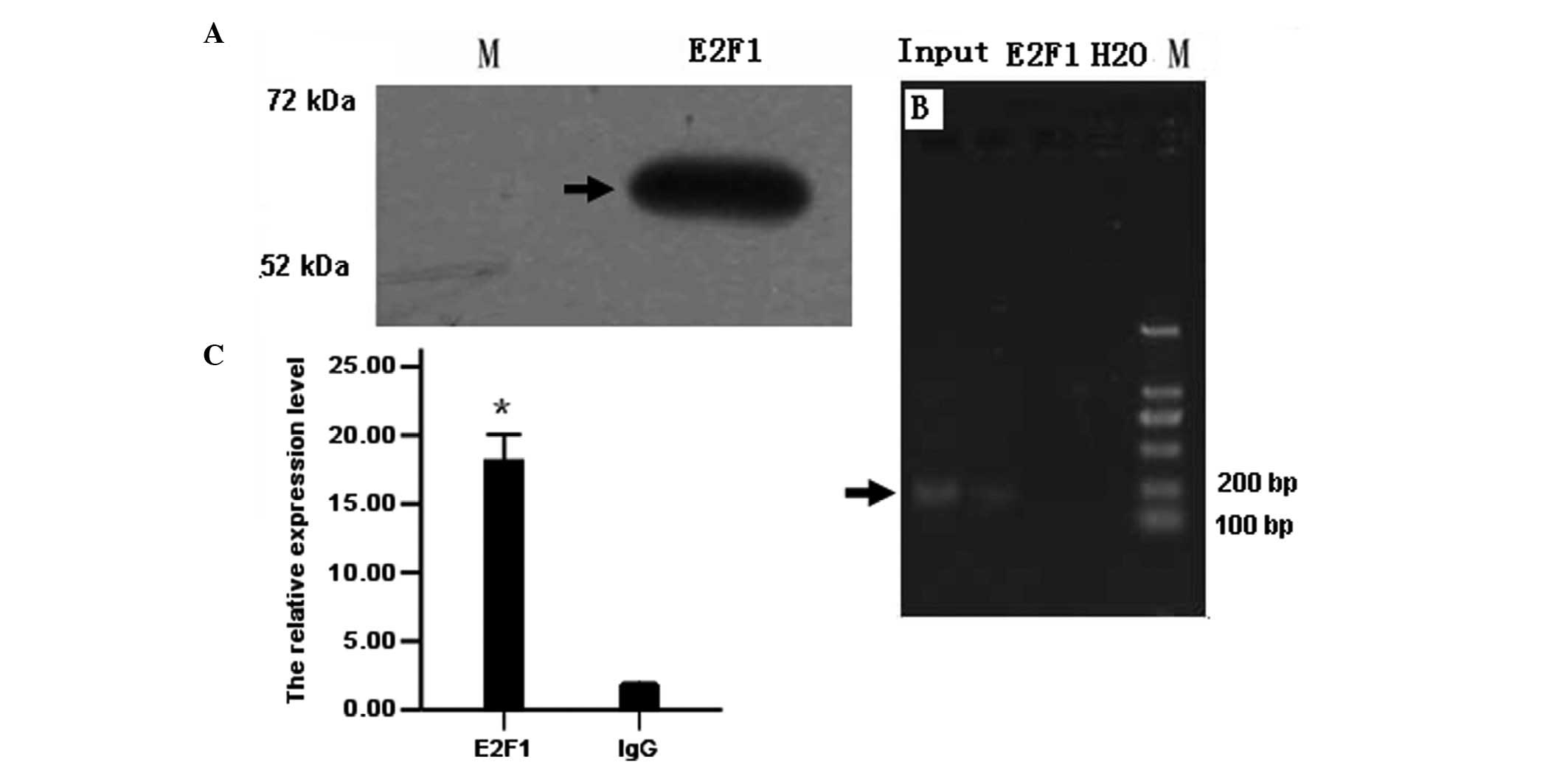microRNA‑202 suppresses MYCN expression under the control of E2F1 in the neuroblastoma cell line LAN‑5
- Authors:
- Published online on: December 6, 2013 https://doi.org/10.3892/mmr.2013.1845
- Pages: 541-546
Abstract
Introduction
Neuroblastoma (NB) is the most common type of extracranial solid tumor of neuroectodermal cell origin in children, occurring most frequently in the adrenal medulla and sympathetic nervous system. Neuroblastoma accounts for 10% of malignant solid tumors in children (1), with ~75% of cases occurring prior to 5 years of age. The biological characteristics of NB are diverse and unique compared with other types of cancer of the nervous system. In a number of infants, NB may spontaneously disappear. In other infants, NB may differentiate into benign ganglioneuroma following chemotherapy. However, in the majority of patients with NB, metastases are observed at the time of diagnosis, with rapid progression and mortality being a frequent outcome (2). There is a marked correlation between amplification of the MYC family gene MYCN, rapid progression of NB and poor prognosis (3). A haploid genome, consisting of >10 copies of the MYCN gene, is predictive of poor outcome independent of anatomic staging, age and other clinical variables. By contrast, there is a positive association between MYCN amplification and malignant behavior in NB (4). microRNAs (miRNAs) are endogenous non-coding RNAs of 22 nucleotides that regulate the expression of proteins by binding to complementary sequences in the 3′UTR of target genes. It is well documented that miRNAs regulate a variety of biological processes, including cell proliferation, apoptosis, differentiation and aging (5,6). Accumulating evidence also indicates that miRNAs are involved in a number of pathological conditions, including cancer, cardiac infarction, arrhythmias, viral infection and Alzheimer’s disease (7,8), suggesting that miRNAs are a novel target for therapeutic intervention. miRNA-202 (miR-202) functions as a promoter and suppressor of tumor formation and a regulator of immune function (9–12). The expression of miR-202 is high in human endometrium and adipose tissue-derived stem cells, suggesting that expression levels may be linked to cell cycle control. Furthermore, alterations in miR-202 expression may be associated with the formation of testicular tumors. In addition, miR-202 may regulate the expression of the MYCN gene and thereby inhibit the proliferation of neuroblastoma MNA Kelly cells, which generally exhibit a high MCYN gene copy number (13). This study was designed to examine whether MYCN is a target gene of miR-202 in the neuroblastoma cell line LAN-5, whether miR-202 has a binding site for the transcription factor E2F1 and to define a putative regulatory pathway involving miR-202, MYCN and E2F1. A dysfunctional E2F1/miR-202/MYCN signaling pathway may contribute to malignant transformation or enhance the aggression of neuroblastoma.
Materials and methods
Materials
LAN-5 cells were purchased from Tianjin Ke Ruijie Biological Ltd.. (Tianjin, China), and HEK293T cells were purchased from the Shanghai Institute of Biochemistry and Cell Biology (Shanghai, China). RPMI-1640 medium and Lipofectamine 2000 were purchased from Invitrogen Life Technologies (Carlsbad, CA, USA). Reagents for quantitative polymerase chain reaction (qPCR) were purchased from Takara Bio Inc. (Shiga, Japan). Antibodies against E2F1 and MYCN were purchased from Sigma-Aldrich (St. Louis, MO, USA). Genome sequencing was performed by the Beijing Huada Genomics (Shenzhen, China). Primer premier 5.0 software was used for primer design. The synthesis of primers and the PAGE purification process was performed by Shanghai GenePharma Co., Ltd. (Shanghai, China). The mature sequence of hsa-miR-202 (5′-AGAGGUAUAGGGCAUGGGAA-3′, MIMAT0002811) and an miRNA inhibitor sequence were obtained obtained from miRBase (http://www.mirbase.org/cgi-bin/get_seq.pl?acc=MIMAT0002811). The negative control sequence and negative control inhibitor sequence were purchased from Ruibo Biotechnology, Co., Ltd. (Shanghai, China).
Cell transfection
The experimental culture groups included: i) untransfected LAN-5 cells (control), ii) cells transfected with miR-202 mimics (50 nmol/l), iii) cells transfected with the miR-202 scramble nucleotide sequence (negative control or NC, 50 nmol/l) and iv) cells transfected with an miRNA inhibitor (NI; 100 nmol/l), a negative control for NI (NCI; 50 nmol/l). Cells in log phase growth were seeded on 6-well culture plates (2×105 cells/well) and transfected when the cell fusion rate reached 70%. The RNA-Lipofectamine 2000 compound was added according to the experimental group (1 μl/well to yield 20 nmol/l miRNA). After 36 h, the transfection medium was discarded, the cells were washed with serum-free RPMI-1640 and cultured in RPMI-1640 supplemented with 10% FBS. Fluorescence microscopy was used to determine transfection efficiency.
Quantitative PCR
Total RNA was extracted using TRIzol reagent (Invitrogen Life Technologies) according to the manufacturer’s instructions. Quantitative PCR analysis was performed using an Applied Biosystems 7500 Real-Time PCR system (Foster City, CA, USA). The expression level of 18S RNA was used as an internal control for mRNAs and the U6 expression level was used as an internal control for miRNAs. The primers used for quantitative PCR analysis were as follows: U6 (forward, 5′-GCTTCGGCAGCACAT ATACTAAAAT-3′ and reverse, 5′-CGCTTCACGAATTTGC GTGTCAT-3′), 18S (forward, 5′-CCTGGATACCGCAGCT AGGA-3′ and reverse, 5′-GCGGCGCAATACGAATG CCCC-3′); miR-202 (RT primer, 5′-CTCAACTGGTGTCGTG GAGTCGGCAATTCAGTTGAGTTCCCAT-3′; forward, 5′-ACACTCCAGCTGGGAGAGGTATAGGGCATGG-3′ and reverse, 5′-CTCAACTGGTGTCGTGGA-3′) and MYCN (forward, 5′-CCTGAGCGATTCAGATGA-3′ and reverse, 5′-CATAGTTGTGCTGCTGGT-3′). The expression level was calculated using the 2−ΔΔCt method.
Western blot analysis
LAN-5 cells were lysed in RIPA buffer containing a proteinase inhibitor cocktail (Biocolor BioScience & Technology, Shanghai, China). The protein concentration was determined using bicinchoninic acid (Bioss, Beijing, China). Protein was separated on 10% SDS-PAGE at 30 μg/gel lane and electrotransferred to nitrocellulose membranes. Membranes were incubated with a primary antibody against MYCN (rabbit polyclonal; Cell Biotech, Tianjin, China) at 4°C overnight, washed extensively with 0.1% Tween-20 in PBS and incubated with a secondary antibody conjugated to horseradish peroxidase (1:1,000; Pharmingen, Becton Dickinson, San Diego, CA, USA) at room temperature for 3 h. Immunolabeling was visualized using the ECL system (Amersham, UK). Expression levels were normalized to the gel loading control and expressed as fold changes compared with baseline (pretransfection) values.
Luciferase reporter assay
The 3′UTR fragments of the MYCN gene were obtained by PCR amplification and cloned separately into multiple cloning sites of the psi-CHECK™-2 luciferase miRNA expression reporter vector. HEK293T cells were transfected with miR-202 mimic, miR-202 inhibitor, a control miRNA, a miRNA inhibitor or empty plasmid using Lipofectamine 2000 (Invitrogen Life Technologies) according to the manufacturer’s instructions. Nucleotide substitution mutation analysis was performed using direct oligomer synthesis of MYCN 3′UTR sequences. The constructs were verified by sequencing. Luciferase activity was measured using the dual luciferase reporter assay system kit (Promega, Madison, WI, USA) according to the manufacturer’s instructions on a Tecan M200 luminescence reader.
Rapid amplification of 5′cDNA ends (5′RACE)
The 5′RACE measurements were conducted according to the manufacturer’s instructions (Invitrogen Life Technologies). Briefly, total RNA was extracted from LAN-5 cells with TRIzol reagent (Invitrogen Life Technologies). PCR reactions were performed using the universal sense primer provided in the 5′RACE kit and antisense primers (miR-202 outer, 5′-TTAGGCCAG ATCCTCAAAGAAG-3′, miR-202 inter, ATAGGAAAAAG GAACGGCGG) specific for the miR-202 coding sequence. The PCR product was cloned and sequenced.
Chromatin immunoprecipitation (ChIP) assay
Neuroblastoma cells were cultured in 10-cm dishes at 5×106/dish. Ice-cold PBS (10 ml) was added to each dish, followed by panning and washing on a horizontal shaker (3×1 min). Formaldehyde (1% in PBS) was used for crosslinking covalently stabilized protein-DNA complexes. The ultrasonic slicing method was used to cut DNA fragments bound to protein into 200–1,000 bp fragments. Following centrifugation, the supernatant was collected, added to Protein A Agarose and mixed for 1 h. A 10 μl aliquot was reserved as the input for later use. Antibodies against E2F1 were added to the remaining supernatant for co-immunoprecipitation and incubated with Protein A Agarose. Following precipitation with low salt solution and centrifugation, the supernatant was discarded and the protein-DNA pellet separated by elution to obtain the DNA template. The gene-specific primers were designed according to the sequence of miR-202 (5′-GTTCTGCTGCTGCCGAGCGAG-3′ and 5′-CCTGGCTCAGCACTCTTCTCACA-3′). Quantitative PCR was performed to measure target DNA levels in the purified DNA products.
Data analysis
The results are the averages of at least three independent experiments from separately treated and transfected cultures. Data are expressed as the mean ± SD. Statistical comparisons were made by one-way analysis of variance (ANOVA). P<0.05 was considered to indicate a statistically significant difference.
Results
Expression of miR-202 in LAN-5 transfection groups
After the cells were transfected with the miR-202 mimic, miR-202 inhibitor or appropriated controls for 36 h, qPCR was performed to assess miR-202 expression (Fig. 1). Expression was significantly higher in cultures transfected with miR-202 mimic compared with untransfected controls, while expression was significantly inhibited (P<0.05) in the group transfected with the inhibitor (NI group) compared with untransfected cultures or cultures transfected with the inhibitor control transcript (NIC group).
Effect of miR-202 on expression of MYCN
After neuroblastoma cells in each group were transfected with miR-202 mimic, miR-202 inhibitor or left untransfected for 48 h, qPCR was performed to detect the relative expression levels of MYCN mRNA. There was no significant difference in MTCN mRNA expression among the miR-202 mimic group, blank control group (untransfected) and the miRNA negative control group (P>0.05; Fig. 2A). However, western blot analysis of the MYCN protein revealed significant differences among the miR-202 mimic group and the negative control group (P<0.05) (Fig. 2B and C), suggesting that miR-202 inhibits translation of MYCN.
miR-202 binds to the MYCN 3′UTR
TargetScan (human 6.2 version), a miRNA target gene prediction software application, predicted two miR-202 binding sites at 505 and 869 bp in the MYCN 3′UTR sequence. The full-length sequence of the MYCN 3′UTR (910 bp) was cloned downstream of the luciferase gene in the psiCHECK carrier to construct the psiCHECK-2-MYCN 3′UTR carrier. LAN-5 cells were cotransfected with the miR-202 mimic vector and vectors carrying mutations in the MYCN 3′UTR-binding site 1 (505 bp), binding site 2 (869 bp) or both, to confirm direct binding of miR-202 and MYCN 3′UTR. Cotransfection of LAN-5 cells with miR-202 mimic and psiCHECK-2 MYCN 3′UTR significantly inhibited luciferase activity (P<0.05), while transfection with vectors carrying a mutation at binding sites 1 and 2 or both vectors had little effect on luciferase activity, indicating that miR-202 may directly regulate the expression of MYCN by binding to target sites within the MYCN 3′UTR sequence (Fig. 3).
Transcription initiation site for miR-202 determined by 5′RACE assay
Downstream-specific primers were designed to amplify the miR-202 gene by PCR (Fig. 4). Specific bands were observed corresponding to miR-202-1, -2 and -3. The miR-202-1 band was the largest at >300 bp. The primary transcriptional copy of miR-202 was ~300 bp. The DNA fragments were separated from the protein, recovered from the gel and cloned on the T-vector for sequencing. Sequences of the acquired DNA fragments were compared and the start site for transcription was determined to be a T-vector 312 bp upstream of the miR-202 stem-loop sequence. ConSite, a transcription factor prediction software (obtained at http://asp.ii.uib.no:8090/cgi-bin/CONSITE/consite) predicted an E2F1 binding site +17 bp upstream of the initiation site of miR-202.
Binding of E2F1 to the miR-202 promoter as revealed by ChIP assay
ChIP assay was used to verify the predicted binding sites of E2F1 +17 bp upstream of the miR-202 initiation site. First, western blot analysis was used to detect the expression of E2F1 in LAN-5 cells. Electrophoresis of ChIP assay produced positive bands for the E2F1 antibody group but none for the negative control IgG group or blank group (water). Results from quantitative PCR showed that in lysates, including the E2F1 antibody, the relative expression of E2F1 amplified by the E2F1ChIPF/R primer was ~18-fold higher than that in the negative group, suggesting that the DNA was isolated using the E2F1 antibody containing the predicted miR-202 promoter sequence. These results indicate that E2F1 may directly bind to the promoter sequence of miR-202 (Fig. 5).
Discussion
Amplification and overexpression of the MYCN oncogene is frequently observed in NB. Tumors with the MYCN amplification exhibit an invasive growth pattern, malignant proliferation of cancer cells, a rapid increase in tumor volume, rupture through the tumor capsule and invasion of surrounding tissues, early systemic metastasis, poor prognosis and high mortality (14). This study of the molecular mechanisms of MYCN regulation by miR-202 defines a potential regulatory pathway for control of cell proliferation and a promising therapeutic target for the treatment of NB (15).
miRNAs regulate a variety of critical biological processes by controlling the expression of target genes, including genes involved in cell proliferation, apoptosis and malignant transformation (16). miRNAs may inhibit translation or activate mRNA degradation through complementary pairing with a 3′UTR sequence (17). Bioinformatics prediction provides a convenient and powerful method for identifying potential miRNA target genes (18). TargetScan, the standard software for prediction of miRNA target genes, predicted two possible binding sites on the MYCN 3′UTR for miR-202 and it was confirmed that they are indeed regulatory sites for MYCN expression. miR-202 overexpression significantly reduced the luciferase activity of a vector containing MYCN 3′UTR and mutation of these potential miR-202 binding sites significantly reduced the inhibitory effect of miR-202 on luciferase activity (Fig. 3). Through these direct binding sites for miR-202 on MYCN, miR-202 overexpression may significantly reduce the expression of MYCN protein (Fig. 2B and C). However, miR-202 had no effect on the expression of MYCN mRNA (Fig. 2A), indicating that miR-202 binding to the 3′UTR suppresses MYCN expression at the post-transcriptional level.
The E2F1 transcription factor is the most significant activator governing the transition from G1 to S phase and thus, is a key regulator of cell proliferation. The Rb/E2F complex is a critical intermediary step in this process (19). In normal cells, Rb in the low phosphorylation state and E2F, form a complex that inhibits the transcription of the proto-oncogenes c-myc, c-fos and others to inhibit cell growth. By contrast, highly phosphorylated Rb and E2F initiates downstream gene expression and promotes cell cycle progression (20,21). Thus, E2F plays a dual role depending on the phosphorylation status of Rb. Previous studies have shown that E2F activity is required for MYCN overexpression in neuroblastoma cells (13,14). In IMR-32 cells, overexpression of cP16INK4A may shift Rb to the low phosphorylation state, decreasing E2F1 activity and downregulating MYCN expression (22–24). In the current study, E2F1 was observed to bind to the miR-202 promoter and miR-202 was observed to directly target MYCN (Figs. 4 and 5). Previous studies demonstrated that miR-202 directly binds to MYCN in SMS-KMN cells, thereby downregulating MYCN expression. A potential negative feed-forward loop may exist among E2F1, miR-202 and MYCN. Under normal circumstances, E2F1 indirectly inhibits MYCN activity by upregulating miR-202, thus preventing excessive activation of MYCN by E2F1. A dynamic balance among these three molecules may maintain normal cell growth. However, this balance is disturbed in nascent neuroblastoma cells, with eventual loss of MYCN regulation and malignant transformation.
Therefore, elucidation of the molecular mechanisms regulating E2F1, miR-202 and MYCN may identify novel molecular targets for the treatment of NB and aid in the development of novel therapeutic strategies.
Acknowledgements
This study was supported by grants from the Guangdong Science and Technology Department Social Development Projects (no. 2011B080702011) and the Technical New Star of Zhujiang, Pan Yu districts, Guangzhou.
References
|
Brodeur GM: Neuroblastoma: biological insights into a clinical enigma. Nat Rev Cancer. 3:203–216. 2003. View Article : Google Scholar : PubMed/NCBI | |
|
Attiyeh EF, London WB, Mossé YP, Wang Q, Winter C, et al: Chromosome 1p and 11q deletions and outcome in neuroblastoma. N Engl J Med. 353:2243–2253. 2005. View Article : Google Scholar : PubMed/NCBI | |
|
Brodeur GM, Seeger RC, Schwab M, Varmus HE and Bishop JM: Amplification of N-myc in untreated human neuroblastomas correlates with advanced disease stage. Science. 224:1121–1124. 1984. View Article : Google Scholar : PubMed/NCBI | |
|
Esquela-Kerscher A and Slack FJ: Oncomirs - microRNAs with a role in cancer. Nat Rev Cancer. 6:259–269. 2006. View Article : Google Scholar | |
|
Lim LP, Lau NC, Weinstein EG, et al: The microRNAs of Caenorhabditis elegans. Genes Dev. 17:991–1008. 2003. | |
|
Berezikov E, Guryev V, van de Belt J, et al: Phylogenetic shadowing and computational identification of human microRNA genes. Cell. 120:21–24. 2005. View Article : Google Scholar : PubMed/NCBI | |
|
Cai B, Pan Z and Lu Y: The roles of microRNAs in heart diseases: a novel important regulator. Curr Med Chem. 17:407–411. 2010. View Article : Google Scholar : PubMed/NCBI | |
|
Wang Y, Liang Y and Lu Q: MicroRNA epigenetic alterations: predicting biomarkers and therapeutic targets in human diseases. Clin Genet. 74:307–315. 2008. View Article : Google Scholar : PubMed/NCBI | |
|
Couzin J: MicroRNAs make big impression in disease after disease. Science. 319:1782–1784. 2008. View Article : Google Scholar : PubMed/NCBI | |
|
Hawkins SM, Creighton CJ, Han DY, et al: Functional microRNA involved in endometriosis. Mol Endocrinol. 25:821–832. 2011. View Article : Google Scholar : PubMed/NCBI | |
|
Novotny GW, Nielsen JE, Sonne SB, et al: Analysis of gene expression in normal and neoplastic human testis: new roles of RNA. Int J Androl. 30:316–326. 2007. View Article : Google Scholar : PubMed/NCBI | |
|
Cho JA, Park H, Lim EH and Lee KW: MicroRNA expression profiling in neurogenesis of adipose tissue-derived stem cells. J Genet. 90:81–93. 2011. View Article : Google Scholar : PubMed/NCBI | |
|
Buechner J, Tømte E, Haug BH, et al: Tumour-suppressor microRNAs let-7 and mir-101 target the proto-oncogene MYCN and inhibit cell proliferation in MYCN-amplified neuroblastoma. Br J Cancer. 105:296–303. 2011. View Article : Google Scholar : PubMed/NCBI | |
|
Wei JS, Song YK, Durinck S, Chen QR, Cheuk AT, et al: The MYCN oncogene is a direct target of miR-34a. Oncogene. 27:5204–5213. 2008. View Article : Google Scholar : PubMed/NCBI | |
|
Schulte JH, Horn S, Otto T, Samans B, Heukamp LC, et al: MYCN regulates oncogenic MicroRNAs in neuroblastoma. Int J Cancer. 122:699–704. 2008. View Article : Google Scholar : PubMed/NCBI | |
|
Bartel DP: MicroRNAs: target recognition and regulatory functions. Cell. 136:215–333. 2009. View Article : Google Scholar : PubMed/NCBI | |
|
Hornstein E and Shomron N: Canalization of development by microRNAs. Nat Genet. 38(Suppl): S20–S24. 2006. View Article : Google Scholar | |
|
Peterson KJ, Dietrich MR and McPeek MA: MicroRNAs and metazoan macroevolution: insights into canalization, complexity, and the Cambrian explosion. Bioessays. 31:736–747. 2009. View Article : Google Scholar : PubMed/NCBI | |
|
Harbour JW and Dean DC: The Rb/E2F pathway: expanding roles and emerging paradigms. Genes Dev. 14:2393–2409. 2000. View Article : Google Scholar : PubMed/NCBI | |
|
Trimarchi JM and Lees JA: Sibling rivalry in the E2F family. Nat Rev Mol Cell Biol. 3:11–20. 2002. View Article : Google Scholar : PubMed/NCBI | |
|
Rabinovich A, Jin VX, Rabinovich R, Xu X and Farnham PJ: E2F in vivo binding specificity: comparison of consensus versus nonconsensus binding sites. Genome Res. 18:1763–1777. 2008. View Article : Google Scholar : PubMed/NCBI | |
|
Chen CR, Kang Y, Siegel P and Massagué J: E2F4/5 and p107 as Smad cofactors linking the TGFbeta receptor to c-myc repression. Cell. 110:19–32. 2002. View Article : Google Scholar : PubMed/NCBI | |
|
Lacerte A, Korah J, Roy M, Yang XJ, Lemay S and Lebrun JJ: Transforming growth factor-beta inhibits telomerase through SMAD3 and E2F transcription factors. Cell Signal. 20:50–59. 2008. View Article : Google Scholar : PubMed/NCBI | |
|
Emmrich S and Pützer BM: Checks and balances: E2F-microRNA crosstalk in cancer control. Cell Cycle. 9:2555–2567. 2010. View Article : Google Scholar : PubMed/NCBI |



